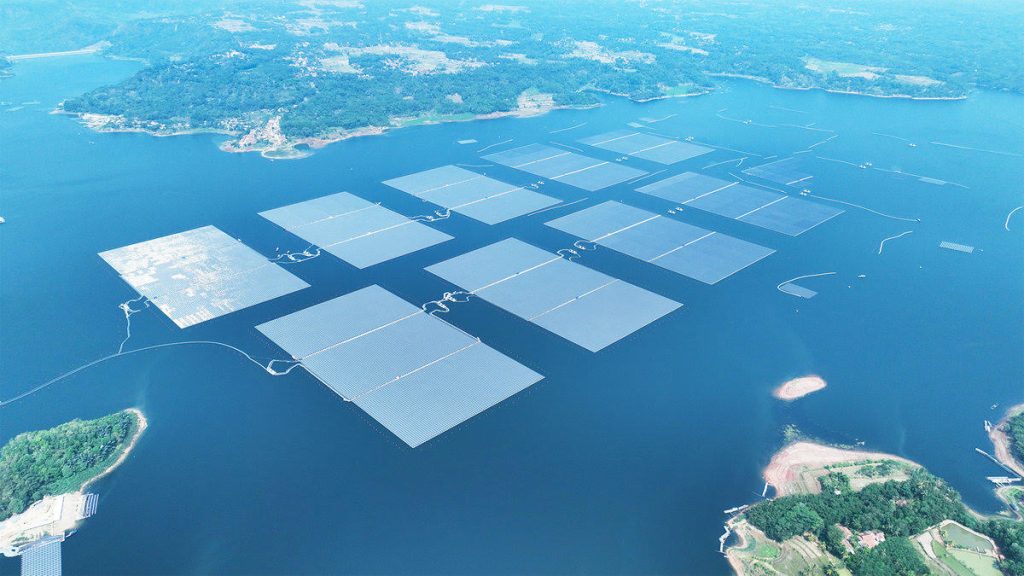Indonesia, the world’s largest archipelago with over 17,000 islands, is making significant strides toward a sustainable energy future. At the forefront of this transition is the Cirata Floating Solar Farm, Southeast Asia’s largest floating photovoltaic (PV) installation, located on the Cirata Reservoir in West Java, approximately 100 kilometers from Jakarta. This innovative project, which generates 192 megawatts (MW) of clean electricity—enough to power 50,000 homes—represents a bold step toward Indonesia’s net-zero emissions goal by 2060.
A Vision for Renewable Energy
The Cirata Floating Solar Farm, spanning 250 hectares, is a collaboration between the Indonesian government and Masdar, an Abu Dhabi-based renewable energy company. With an estimated cost of $100 million, the project features 340,000 solar panels floating on the reservoir’s surface, harnessing Indonesia’s abundant solar potential, which averages 4.8 kWh/m²/day—significantly higher than many other countries, such as Germany. This initiative not only delivers clean energy but also avoids competing for valuable agricultural or residential land, a critical consideration in Indonesia’s densely populated regions.
The project’s strategic importance lies in its alignment with Indonesia’s broader renewable energy ambitions. The country aims to generate 100 gigawatts (GW) of clean power by 2040, requiring an estimated $235 billion in investments for solar, wind, and geothermal energy. The Cirata array, described by ABB—a key manufacturing and engineering partner—as a model for global economies, demonstrates how floating solar farms, or “floatovoltaics,” can address land scarcity while meeting rising energy demands.
Environmental and Economic Impact
The Cirata Floating Solar Farm is expected to prevent approximately 214,000 tons of carbon dioxide emissions annually, making a significant contribution to Indonesia’s net-zero emissions target. By utilizing the reservoir’s surface, the project minimizes environmental disruption compared to land-based solar farms, preserving ecosystems and avoiding deforestation—a critical issue in Indonesia, where palm oil production has historically led to significant environmental degradation.
Economically, the project creates high-value green jobs and supports Indonesia’s push for energy self-sufficiency. President Prabowo Subianto, who inaugurated clean energy projects across 15 provinces on June 26, 2025, emphasized the importance of such initiatives for national development. The Cirata array is part of a broader $1.56 billion investment in renewable energy projects, including solar and geothermal plants with a combined capacity of 379.7 MW, showcasing Indonesia’s commitment to sustainable growth.
Technological Innovation and Scalability
Floating solar arrays like Cirata offer unique advantages. By sitting on water, the panels benefit from natural cooling, which enhances efficiency and extends their lifespan. Indonesia’s geography, with over 100 reservoirs and 500 lakes, makes it an ideal candidate for scaling up floating solar projects. Currently, 60 additional floating PV projects are in the planning stages, signaling a robust pipeline for expanding clean energy infrastructure without sacrificing arable land.
The Cirata project also integrates with Indonesia’s efforts to modernize its electricity grid. With support from the United Nations, the Java-Bali-Madura grid, serving over 160 million people, is being upgraded to a “smart grid” capable of managing the variable output of renewable sources like solar and wind. This modernization ensures that clean energy from projects like Cirata can be efficiently distributed to consumers.
Challenges and Broader Context
Despite its progress, Indonesia faces challenges in its renewable energy transition. As of mid-2024, renewables account for only 15% of the country’s total primary energy supply, with an installed capacity of 13.5 GW—well below the 32 GW target for 2030. Achieving net-zero emissions by 2060 will require accelerated investment, regulatory clarity, and technological advancements. Additionally, Indonesia’s reliance on fossil fuels, including coal and palm oil-based biodiesel, poses environmental trade-offs. For instance, palm oil, while marketed as a renewable energy source, has been criticized for its environmental impact, including deforestation and habitat loss.
The global demand for nickel, a key component in electric vehicle (EV) batteries, further complicates Indonesia’s sustainability efforts. As the world’s largest nickel producer, Indonesia has seen a boom in mining, particularly in Sulawesi and Maluku, which threatens biodiversity and local communities. Balancing the economic benefits of nickel production with environmental preservation remains a critical challenge.
A Model for the Future
The Cirata Floating Solar Farm stands as a beacon of Indonesia’s renewable energy potential. Ken Yap, Commercial Vice President at ABB Electrification Indonesia, highlighted its global significance: “This project is not only strategically important for Indonesia but also sets an example for other global economies looking to bolster their decarbonization plans with floating solar technology.”
As Indonesia continues to develop its renewable energy infrastructure, projects like Cirata could position the country as a leader in distributed renewable systems. The Climate Impact Innovations Challenge (CIIC) 2025 envisions scaling up to 1,000 AI-powered microgrids by 2035, providing clean electricity to 50 million Indonesians and establishing Indonesia as a global knowledge hub for renewable energy.
Conclusion
The Cirata Floating Solar Farm is more than a power plant; it is a symbol of Indonesia’s commitment to a sustainable, net-zero future. By leveraging its abundant natural resources and innovative technologies, Indonesia is transforming its energy landscape while addressing global climate challenges. As the country continues to invest in clean energy, the Cirata project serves as a blueprint for other nations seeking to balance economic growth with environmental stewardship. With continued focus and investment, Indonesia’s 17,000 islands could become a global model for distributed, intelligent, and sustainable energy systems.
RELATED ARTICLE: Iberdrola Awarded its First Floating Solar Project in Alsace

